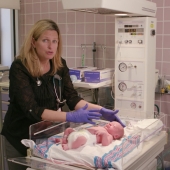VBAC is the vaginal birth after cesarean section. If you have previously had a cesarean section you will be seeing a consultant during your pregnancy. At around 36 weeks following a discussion with your midwife and obstetrician you will have to decide whether to book an elective repeat cesarean section or plan a VBAC.
Our overall aim is to ensure a healthy mother gives birth to a healthy baby but having a safe and satisfying experience. You should receive an information leaflet about the VBAC. The decision regarding VBAC will be influenced by a number of factors. Taking into account how this pregnancy is progressing, your feelings, plans for future children and the reason for your previous cesarean.
Approximately 3 out of 4 women will have a successful vaginal birth if they have had one previous cesarean and their current pregnancy is uncomplicated. There are many benefits to having a VBAC including quicker recovery, no driving restrictions.
Be sure to hospital stay to avoid all the risks associated with an operation and increase the likelihood of having subsequent vagina birth. You may also find that breastfeeding is easier to establish with an ability to move more freely. There is also a much lower risk of breathing difficulties for your baby.
There are some factors that make you less likely to achieve of the vaginal birth. These include having a BMI of over 30 at your booking appointment or being over the age of 40. The need to be induced or having a baby that is predicted to be over four kilograms. There is also less chance of success if it is less than 12 months since your previous cesarean or the previous cesarean was for an obstructed labor.
Normally a VBAC is not recommended if you've had three or more previous cesarean, if you had a previous rupture or if you previously had a classical scar which is a vertical incision on your uterus. If you decide to have a VBAC there are potential problems that may arise. 25% of women will need a cesarean normally due to labor slowing or concern for the well-being of your baby. There is a small chance that the scar on your uterus may separate and/or tear.
This is known as dehiscence or rupture. If you go into labor naturally the chance of this happening is one in 200 women, 0.5%. If you are induced the risk increases by two to three times. There are normally warning signs of these complications and your baby will then be delivered by caesarian. Serious consequences for you and your baby are rare. Serious risks to your baby such as stillbirth and low oxygen levels causing damage are higher than for a planned cesarean but the same as they were in your first labor.
If you have a VBAC there are some things that we recommend. Firstly it would be recommended that you have your baby in hospital on the labor ward. We recommend that your baby is continuously monitored and you have an intravenous cannula when you are in established labor. Your progress in labor should be assessed regularly. An early consideration for caesarean if it is indicated.
We also advise that pushing is limited to one hour in the second stage. Pain relief is managed in the same as in any other labor and we would still encourage you to spend the early stages of labor at home. It is still advised that you stay immobile in labor and use breathing and relaxation methods discussed in the other videos.
It is important to consider what will happen if you do not go into labor spontaneously. You may wish to opt for an induction of labor or a caesarean section. Some people will choose to plan a cesarean section. There are also risks associated with this. It may be a longer and more difficult operation due to previous scar tissue. This means that there is a risk of damage to your bladder and bowel.
It also increases the risk of the percenter growing into the previous scar making a removal difficult in future pregnancies. This can lead to bleeding which could require a hysterectomy removal of the uterus. The recovery time will be longer and it's recommended that you don't drive to six weeks with an elective section.
There is more chance of your baby having breathing problems and being admitted to the neonatal unit. Four to five babies in every 100 have problems. This normally resolves over a short period of time and there are no long-term problems. All serious risks increase with every severe infection you have. If you choose to have an elective cesarean, it will normally be booked around 39 weeks. It is important to consider what you would want.
If you went into labor before your birth date as this occurs with one woman in every ten every woman, is very individual and therefore you should always have a discussion with your midwife and consultant to decide what is best for you and your family.
- 4588 views













